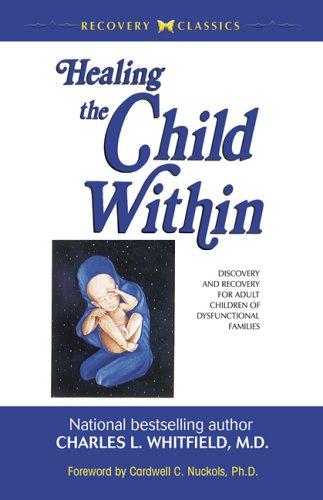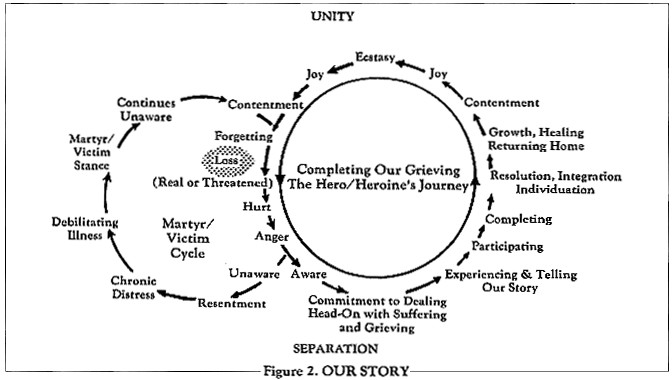Healing the Child Within:
Discovery and Recovery for Adult Children of Dysfunctional Families

Chapter 12
Continuing to Grieve: Risking, Sharing and Telling Our Story
Risking
When we risk, we expose ourself, our Child Within, our True Self. We take a chance and we become vulnerable. When we do this, two extreme outcomes may emerge acceptance or rejection. Whatever we may decide to risk about ourself, another may accept, reject or they may react somewhere in between.
Many of us may have been so wounded from risking whether in our childhood, adolescence, adulthood or all three that we are usually reluctant or unable to risk and share our Real Self with others. Yet we are caught in a dilemma: when we hold in our feelings, thoughts, concerns and creativities, our Child Within becomes stifled and we feel bad, we hurt. Our held-in energy may build up so much that the only way we can handle it is to let it out to someone. This is the predicament that many of us who grew up in troubled families encounter. And because of a number of factors, such as our seeking approval, validation, excitement and intimacy, we may select someone who is not safe and supportive. Indeed, they may reject us or betray us in some way, which may just confirm our reluctance to risk. So we hold in all our feelings
again and the cycle continues. Yet to heal our Child Within we have to share it with others. So where do we start?
Rather than hold it in and then let it out impulsively or haphazardly, we can begin a step at a time. Find someone who we know is safe and supportive, such as a trusted friend, a counselor or therapist, a therapy group or a sponsor. Begin by risking one little thing. Follow the share-check-share guideline described above (Gravitz, Bowden, 1985). If it works, share some more.
Risking and sharing involves several other core issues, including trust, control, feelings, fear of abandonment, all-or-none thinking and behaving, and high tolerance for inappropriate behavior. When any of these issues come up, it can be useful to consider, and even to begin talking about it with safe people.
As we risk, we can eventually begin to tell our story.
Telling Our Story
Telling our story is a powerful act in discovering and healing our Child Within. It is a foundation of recovery in self-help groups, group therapy and individual psychotherapy and counseling. I describe some of the dynamics of story telling in Alcoholism and Spirituality.
Each of our stories when complete contains three basic parts: separation, initiation and return (Campbell, 1949). Twelve-Step self-help groups describe their stories as "What we were like," "What happened" and "What we are like now." People in group therapy may call it risking, sharing, participating and ''working" in group. In individual counseling or psychotherapy we may describe it by similar names, and psychoanalysts may call it ''free association, working through transference and through unsolved internal conflict." Among close friends, we may call it "baring our souls" or "having a heart-to-heart talk."
In sharing and telling our story we can be aware that gossip and wallowing in our pain are usually counterproductive to heating. This is in part because gossip tends to be attacking rather than self-disclosing and it is generally incomplete, following the victim stance or cycle. Wallowing in our pain is continuing to express our suffering beyond a reasonable duration for healthy grieving. There is a danger here that may be observed in some self-help meetings: When a person tries to tell a painful story that has no apparent or immediate resolution, the other members may unknowingly label it as "self-pity" or a "pity party." In this case, while self-help meetings are generally safe and supportive, the bereaved may wish to look elsewhere to express their pain.
Simos (1979) said, "Grief work must be shared. In sharing, however, there must be no impatience, censure or boredom with the repetition, because repetition is necessary for catharsis and internalization and eventual unconscious acceptance of the reality of the loss. The bereaved are sensitive to the feelings of others and will not only refrain from revealing feelings to those they consider unequal to the burden of sharing the grief but may even try to comfort the helpers" (i.e., the listener).
Our story does not have to be a classical "drunkalog" or long in length. In telling our story we talk about what is important, meaningful, confusing, conflicting or painful in our life. We risk, share, interact, discover and more. And by so doing we heal ourselves. While we can listen to the stories of others, and they can listen to ours, perhaps the most healing feature is that we, the story teller, get to hear our own story. While we may have an idea about what our story is whenever we tell it, it usually comes out different from what we initially thought.
I have illustrated our story in Figure 2. Starting at the point on the circle called "contentment," we can forget that we are in our story. Eventually in our day-to-day life we experience a loss, whether it be a real or a threatened loss. The stage is now set for both grieving and growing. In Figure 2 1 have summarized most of the initial pain of our grieving as hurt. And when we feel hurt, we tend to get angry.
At this crucial point we have a possibility of becoming aware that we have experienced a loss or are suffering an upset. And here we can choose to make a commitment to facing our suffering and grieving head-on. We can call this cycle of our story a "completed" one or the "hero/heroine's journey." Or we may remain unaware of the possibility of working through our suffering around our loss or upset. We may then begin to build up a resentment and/or to blame ourselves, which eventually leads to stress-related illness, and to more prolonged suffering than if we had worked through our upset and our grieving in the first place. We can call this cycle the "victim cycle" or the ''martyr/victim stance."

Figure 2. Our Story
If we commit to work through our pain and grieving, we then begin to share, ventilate, participate and to experience our suffering. We may need to tell our story in such a fashion several times periodically over a period of several hours, days, weeks or even months in order to finally complete our story. We may also have to consider it in other ways, mull it over, dream about it and even tell it again.
While this has been painful for us, we are now complete with our upset or conflict. We are free of its pain. Our conflict is now resolved and integrated. We have learned from it. We have healed our Child Within and have grown. And we can settle back to our natural state of our Child Within, which is contentment, joy and creativity.
However, to begin to tell our story may be difficult. And when we tell it, it may be difficult to express our feelings around it. And among our most difficult feelings to recognize and to express is anger.
Anger is a major component in grieving and in healing our Child Within.
